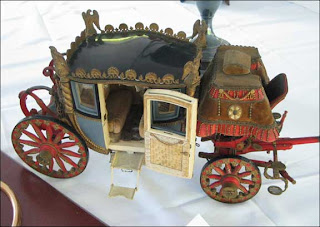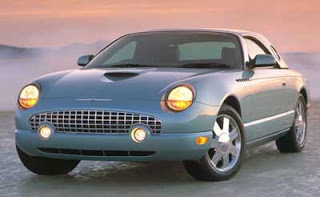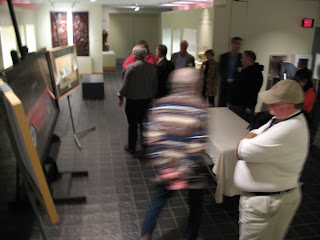He attended the College of Wooster for a liberal arts education at the urging of his parents but his real goal was a career in automobile design. He wrote to General Motors asking about job opportunities and their response suggested the industrial design program at Pratt Institute.
 At Pratt Institute, one of Harry's student projects was this image of a mechanical man made from car parts. It was later published in Rodding and Re-Styling magazine. While still attending the design program, Harry launched his own business as a custom design consultant and began to contribute regularly to various automotive publications.
At Pratt Institute, one of Harry's student projects was this image of a mechanical man made from car parts. It was later published in Rodding and Re-Styling magazine. While still attending the design program, Harry launched his own business as a custom design consultant and began to contribute regularly to various automotive publications. Kandy Klown is one example of Bradley's published hot rod designs.
Kandy Klown is one example of Bradley's published hot rod designs. Harry was recruited by General Motors during his last semester at Pratt and moved to Detroit in July, 1962. This yellow Cadillac Coupe DeVille proposal was created in 1966. Although it was against company policy, he continued to publish designs for hot rod and custom magazines under the name Mark Fadner.
Harry was recruited by General Motors during his last semester at Pratt and moved to Detroit in July, 1962. This yellow Cadillac Coupe DeVille proposal was created in 1966. Although it was against company policy, he continued to publish designs for hot rod and custom magazines under the name Mark Fadner. Bradley worked in a number of studios during his four year tenure at GM. Above is a slick GT Coupe proposal from 1963.
Bradley worked in a number of studios during his four year tenure at GM. Above is a slick GT Coupe proposal from 1963. The Turbo Titan III was Bradley's vision of a turbine powered show truck in 1965. Harry took advantage of GM's Fellowship study program for a Masters degree at Stanford University. While in California, he did some moonlighting on for custom car builders, the Alexander Brothers.
The Turbo Titan III was Bradley's vision of a turbine powered show truck in 1965. Harry took advantage of GM's Fellowship study program for a Masters degree at Stanford University. While in California, he did some moonlighting on for custom car builders, the Alexander Brothers. The Alexander Brothers had been hired by Chrysler to customize a Dodge A-100 pickup truck to display at car shows. Harry poured himself into the project that was to become a design sensation, the 1966 Deora. Click here to see many more photos of the finished vehicle.
The Alexander Brothers had been hired by Chrysler to customize a Dodge A-100 pickup truck to display at car shows. Harry poured himself into the project that was to become a design sensation, the 1966 Deora. Click here to see many more photos of the finished vehicle.  In the spring of 1966 Harry was recruited away from GM by the Mattel corporation. Mattel wanted to hire a designer from one of Detroit's "Big 3" to create the look of their new Hot Wheels die-cast cars. Bradley's mix of hot rod and mainstream car design proved the perfect combination. The original line had 16 models in bright candy colors with carburetor stacks, mag wheels, chopped roofs and red line tires.
In the spring of 1966 Harry was recruited away from GM by the Mattel corporation. Mattel wanted to hire a designer from one of Detroit's "Big 3" to create the look of their new Hot Wheels die-cast cars. Bradley's mix of hot rod and mainstream car design proved the perfect combination. The original line had 16 models in bright candy colors with carburetor stacks, mag wheels, chopped roofs and red line tires. Although the Hot Wheels were an enormous success, the toy company was unwilling to commit to a second series. So after less than a year with Mattel, Harry resigned to start his own design firm and began work on a variety of projects - including the futuristic Tonka toy dump truck above.
Although the Hot Wheels were an enormous success, the toy company was unwilling to commit to a second series. So after less than a year with Mattel, Harry resigned to start his own design firm and began work on a variety of projects - including the futuristic Tonka toy dump truck above. Bradley's business continued to grow and you could guess if it had four wheels, Harry was asked to design it. Plastic model kits, full-size hot rods and customs, even Indy race cars wore Harry Bradley designs. Many images of Harry Bradley's custom designs can be found on custom car designer and consultant Rik Hoving's online photo archive.
Bradley's business continued to grow and you could guess if it had four wheels, Harry was asked to design it. Plastic model kits, full-size hot rods and customs, even Indy race cars wore Harry Bradley designs. Many images of Harry Bradley's custom designs can be found on custom car designer and consultant Rik Hoving's online photo archive.Harry's 40 year career in the design business has far too many accomplishments for a single blog post. You can be assured I've barely skimmed the surface. Heck, I didn't even get into his 35 years teaching at Art Center in Pasadena, CA.
 In one of those events where life comes full circle, many of Harry Bradley's designs are now displayed in the lobby of Boston's Children's Hospital - the same place where his car design career originally blossomed.
In one of those events where life comes full circle, many of Harry Bradley's designs are now displayed in the lobby of Boston's Children's Hospital - the same place where his car design career originally blossomed. The exhibit was produced by Fred Sharf, a collector, scholar and author who specializes in buying, researching and organizing public exhibitions of design art.
The exhibit was produced by Fred Sharf, a collector, scholar and author who specializes in buying, researching and organizing public exhibitions of design art. Sharf has recently published a book detailing Harry Bradley's facinating life and multi-faceted career in the car design business. It's available from the MFA's Bookstore.
Sharf has recently published a book detailing Harry Bradley's facinating life and multi-faceted career in the car design business. It's available from the MFA's Bookstore.





















 Syd Mead - Fender Blended Sports Car
Syd Mead - Fender Blended Sports Car















 1954 Plymouth Belmont
1954 Plymouth Belmont








